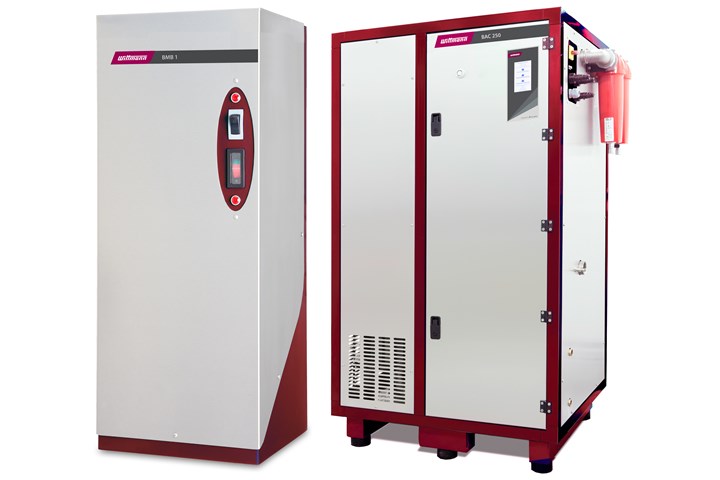Internal Air Cooling Systems Speed Blow Molding
Chilled compressed air cools parts from the inside while the mold cools them on the outside.
Blow molding production increases from at least 15% to more than 50% are promised with Internal Air Cooling Systems (IACS) from Wittmann Battenfeld. These systems were formerly marketed by Farragtech of Austria, which was acquired by Wittmann Group in late 2019. These systems cool the inside of the blown part with chilled compressed air, while the outside of the part is cooled conventionally by the water-cooled mold. This dual-surface cooling not only speeds cycles, but is said to reduce internal stresses compared with cooling on just one side of the part, allowing for thinner walls and weight savings of up to 10% while still passing the same leak, drop and strength tests. As a result, ROI for these systems reportedly is well under a year.

Wittmann Blow Molding Booster (l.) and Blow Air Chiller cool the insides of parts with chilled compressed air.
The IACS offers a choice of two equipment types for exchanging cold air inside the part during the cooling cycle; both were exhibited by Farragtech at K 2019 in Düsseldorf. One is the Blow Molding Booster (BMB), the more economical choice, and also less powerful but less sensitive in terms of compressed-air quality, and also completely maintenance-free, according to the company. It produces a compressed-air temperature of about 5 C (41 F), eliminating the need to dry the compressed air. It requires only compressed air at 6 to 15 bar and a supply of cold, filtered water no warmer than 15 C (59 F). It comes in three sizes from 99.4 to 372.7 scfm, and generally affords production increases from 10% to 35%, according to Wittmann. Compact design typically enables installation right at the molding machine, keeping supply lines short.
Wittmann’s Blow Air Chiller (BAC) is the top-of-the-line IACS offering. It’s said to provide production increases of 35% to aboe 50%. In some cases, blowing and cooling time can even be cut by two-thirds, the company says. This system is more complex; it requires high-quality compressed air at 7 to 15 bar with a residual oil content of 0.01 mg/m3 (0.01 ppb) and a pressure dewpoint of 5 C at 7 bar or less. Inside the BAC, compressed air is fed through the internal Pressure Air Dryer (PAD) with a molecular sieve desiccant, which regenerates itself simply by means of dry compressed air. The PAD lowers the dewpoint of process air to -40 C/F. Like the BMB, the BAC requires a cold water supply at 15 C/59 F or lower at a pressure of 3 to 8 bar.
Both IACS products utilize special Blow Valve Blocks (BVBs) that control flow of cooled compressed air through the core pin into the product and discharge of air from the product via controlled ventilation. Each blow molded product requires its own special core pin to provide the precise distribution of cooling air appropriate to its size and shape.
Related Content
-
Breaking News From NPE2024
Here is a firsthand report of news in injection molding, extrusion, blow molding and recycling not previously covered.
-
How Inline Vision Inspection Can Minimize Scrap in Molding
Once viewed by injection and blow molders as a necessary evil, machine vision technology today can continuously monitor and improve production while reducing costs.
-
NPE2024 Wrap-Up: Sustainability Dominates Show Floor News
Across all process types, sustainability was a big theme at NPE2024. But there was plenty to see in automation and artificial intelligence as well.













